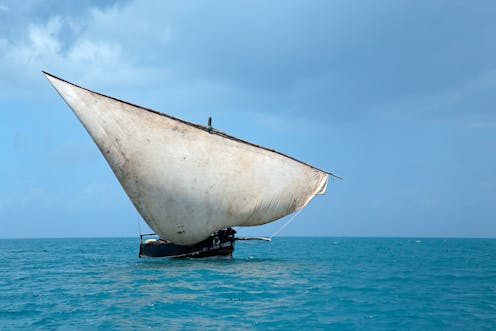
Novels make worlds. They create an intuitive sense and mental image of a place. And the senses of space produced by fiction shape how readers see the world itself, just like maps do.
For early postcolonial literature, the world of the novel was often the nation. Postcolonial novels were usually set within national borders and concerned in some way with national questions. Sometimes the whole story of the novel was taken as an allegory of the nation, whether India or Tanzania. This was important for supporting anti-colonial nationalism, but could also be limiting – land-focused and inward-looking.
My new book Writing Ocean Worlds explores another kind of world of the novel: not the village or nation, but the Indian Ocean world.
The book describes a set of novels in which the Indian Ocean is at the centre of the story. It focuses on the novelists Amitav Ghosh, Abdulrazak Gurnah, Lindsey Collen and Joseph Conrad. Ghosh is a writer based between India and the US whose work includes historical fiction of the Indian Ocean; Gurnah is a novelist from Zanzibar, who was awarded the 2021 Nobel Prize for Literature; Collen is an author and activist based in Mauritius; and Joseph Conrad, is a key figure of the English literary canon.
Read more: Nobel winner Abdulrazak Gurnah's fiction traces small lives with wit and tenderness
These four authors are notable for having centred the Indian Ocean world in the majority of their novels. Each also covers an important region of the Indian Ocean: Ghosh the eastern part, Gurnah the western part, Collen the islands and Conrad an imperial outsider’s view.
Their work reveals a world that is outward-looking – full of movement, border-crossing and south-south interconnection. They’re all very different – from colonially inclined (Conrad) to radically anti-capitalist (Collen), but together draw on and shape a wider sense of Indian Ocean space through themes, images, metaphors and language. This has the effect of remapping the world in the reader’s mind, as centred in the interconnected global south.
Read more: Exploring the Indian Ocean as a rich archive of history – above and below the water line
As the Kenyan novelist Yvonne Adhiambo Owuor has said, the narrative of particularly Africa’s interconnection with the world “seems to have been lost in our post-independence, postcolonial imagination”. As she says, “so much of Africa lies hidden in the sea”.
My book aims to tempt readers to dive into the fiction where it can be found.
The Indian Ocean connection
The Indian Ocean world is a term used to describe the very long-lasting connections among the coasts of east Africa, the Arab coasts, and South and East Asia. These connections were made possible by the geography of the Indian Ocean.
For much of history, travel by sea was much easier than by land, which meant that port cities very far apart were often more easily connected to each other than to much closer inland cities. Historical and archaeological evidence suggests that what we now call globalisation first appeared in the Indian Ocean. This is the interconnected oceanic world referenced and produced by the novels in my book.
The Indian Ocean novel in English is a small but substantial genre, including works also by MG Vassanji, Michael Ondaatje, Romesh Gunesekera, and many others.
Read more: Literature sheds light on the history and mystery of the Southern Ocean
For their part Ghosh, Gurnah, Collen and even Conrad reference a different set of histories and geographies than the ones most commonly found in fiction in English. Those are mostly centred in Europe or the US, assume a background of Christianity and whiteness, and mention places like Paris and New York.
The novels in the book highlight instead a largely Islamic space, feature characters of colour, and centralise the ports of Malindi, Mombasa, Aden, Java and Bombay.
To take one example, in Gurnah’s novel By the Sea, a teacher in Zanzibar is showing his young students their place in the world, and he draws a long continuous line around the east coast of Africa, up and around to India, and through the Malay and Indonesian archipelagos, all the way to China. This, he says, is where we are, circling Zanzibar and pointing eastwards and out to sea. Just outside the classroom:
crowds of sailing ships lie plank to plank in the harbour, the sea between them glistening with slicks of their waste … the streets thronged with Somalis or Suri Arabs or Sindhis, buying and selling and breaking into incomprehensible fights, and at night camping in the open spaces, singing cheerful songs and brewing tea…
It is a densely imagined, richly sensory image of a southern cosmopolitan culture which provides for an enlarged sense of place in the world.
Representing Africa
This remapping is particularly powerful for the representation of Africa. In the fiction, sailors and travellers are not all European. And Africa is not portrayed as a hydrophobic continent which only receives rather than sends out explorers. African as well as Indian and Arab characters are traders, nakhodas (dhow ship captains), runaways, villains, missionaries, activists.
This does not mean that Indian Ocean Africa is romanticised. Migration is often a matter of force; travel is portrayed as abandonment rather than adventure; freedoms are kept from women; and slavery is rife.
What it does mean is that the African part of the Indian Ocean world plays an active role in its long, rich history, and therefore in that of the wider world.
Charne Lavery does not work for, consult, own shares in or receive funding from any company or organization that would benefit from this article, and has disclosed no relevant affiliations beyond their academic appointment.
This article was originally published on The Conversation. Read the original article.







